Picture this: You are an expert who is ready to start your own online consulting business and want to absolutely ace it.
You are a domain expert in your field, yet you have no idea how online consulting businesses work.
You watch multiple videos on YouTube.
You attend numerous webinars.
You listen to every podcast you come across.
But you find no solution and instead come back with quadrupled confusion.
We’ve been there. And we’ve curated the exact steps you need to take to start an online consulting business.
Table of contents
What is online consulting?
Online consulting is a term used to describe consulting businesses that operate mainly in the virtual space through virtual consultations. Simply put, when you provide consultancy services online via phone and video calls, it’s online consulting. The only difference between a regular consultant and an online consultant is that online consultants would predominantly or only interact via a video call.
Also Read: How to Start Providing Online Consultations from Home
Headstart: How to start an online consulting business?
For an online consultant, the aha moment comes when you follow each step from first to last religiously. And here’s every step that you need to discover to get started.
Finding your niche
When you dig deeper into your industry and master the skills in a specific niche, your clients are likely to trust you more.
Why?
Because specialist consultants have expertise in two areas: their skills and knowledge about their industry. This makes them scarce, and clients want to work with such consultants.
But 67.5% of people say they find it hard to find their niche. Probably you have experience in multiple fields so it is very hard to narrow down.
How can you find your niche?
First, understand the different ways you can become a niche-specific online consultant.
Industry-based: This includes offering online consultancy services only to specific industries. For example, you offer consultancy services to edtech and fintech industries.
Location-based: This includes offering online consultancy services only in a specific location. For example, your clientele only includes countries like USA & UK.
Service-based: This includes offering only a few services from the vast set of services. For example, instead of offering marketing consultancy services, you offer SEO consultancy
Here’s an example of niching down:
- Marketing consultant → email marketing consultant
- Email marketing consultant → email marketing consultant for coaches
- Email marketing consultant for coaches → email marketing consultant for female coaches making more than $10,000 per month
- Email marketing consultant for female coaches making more than $10,000 per month → email marketing consultant for female coaches making more than $10,000 per month in the USA
That’s how you go niche.
To find your niche, you need to be a generalist consultant first.
Then focus on three questions:
- What kind of projects do you like working on?
- Do you have a basic understanding of this niche?
- Is the niche profitable?
Answer these questions and you’ll get clarity on your niche.
Take a look at how this freelance writer found her niche and you can use these questions as your guide to finding out yours too.
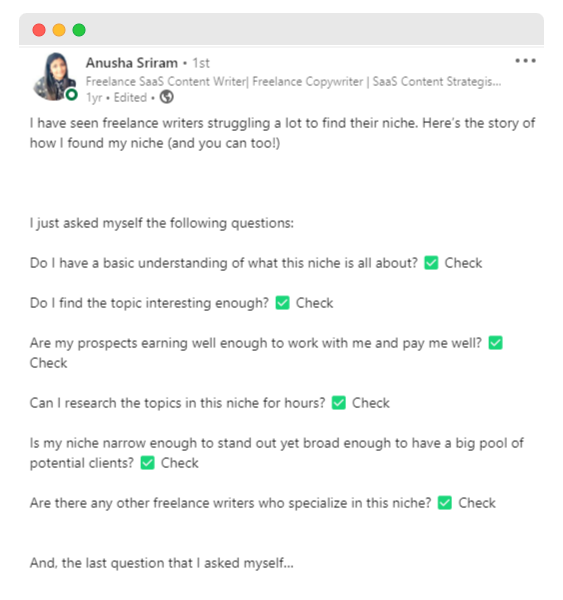
Build a consultant portfolio
As a virtual consultant whose business relies on their skills, you have a solid document to showcase your skills.
And that’s your consultant portfolio.
With your portfolio, you can showcase your expertise, clients you have worked with, and case studies of how you have helped produce great results for your past clients.
Here are a few ways you can present your consultant portfolio.
Google Docs: Have published links to your results or case studies? Compile them together in Google docs and link them in a listicle format.
Here’s how a freelance writer has compiled the list of links and linked them to the relevant published pieces.
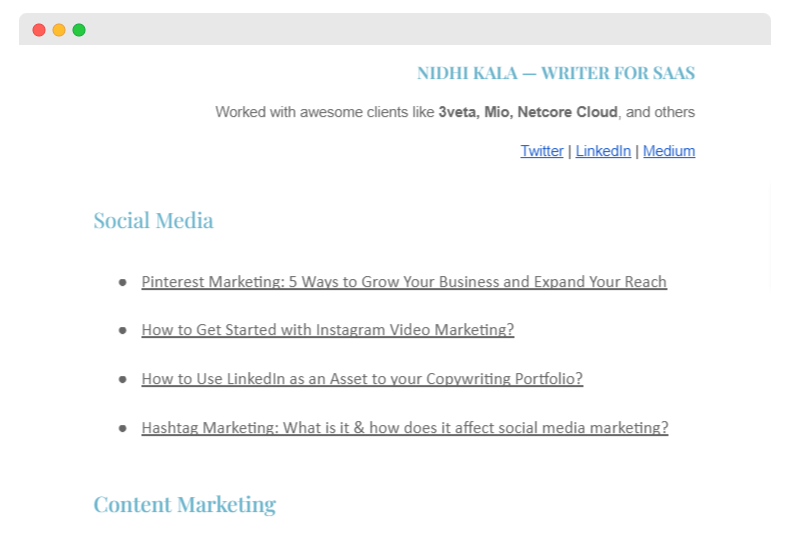
Google Drive: Step up your Google docs portfolio by creating a folder for each service offering. You can add both published and unpublished results to this portfolio.
Linkedin’s feature section: Use LinkedIn’s featured section to add your results and case studies. Two ways to do this:
- Add links to your results or case studies.
- Create a LinkedIn post around your results (attach the images of your results) and add the post to your featured section.
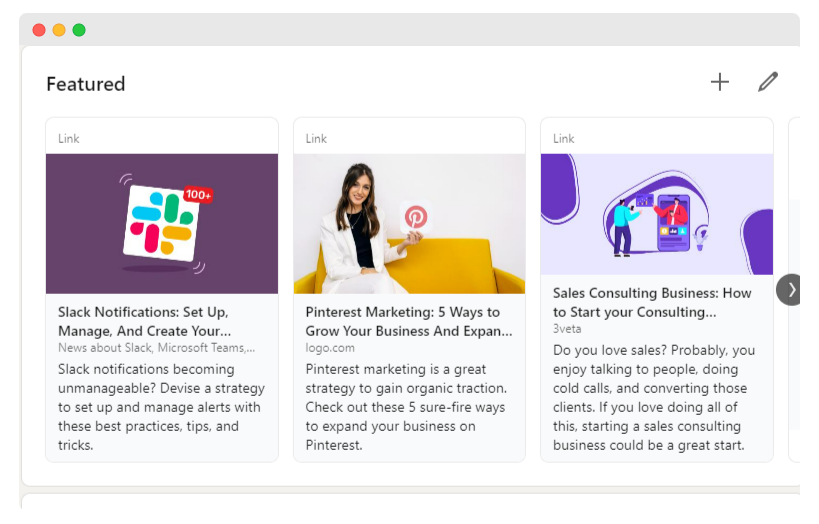
Website: Use website builders like WordPress, Wix, Webflow, or Squarespace to create one. You can also use Notion and Super.so to create a great website. However, creating a website takes gazillion hours from purchasing hosting to adding several plugins.
Most of the time, all you will need is a booking page. That’s basically the place where prospective clients will be able to book a discovery call so both of you can check if you are the right fit.
Here’s a very simple way to build a nice booking page (or a basic website) with 3veta. All you have to do is customize it to your requirements.
How to do it?
- Log in to your 3veta account and select ‘My page.’
- Under ‘My page’, select ‘Booking page’ or ‘Website’ depending on your preferences. Then you’ll see a new page where you can customize your website like the one below.
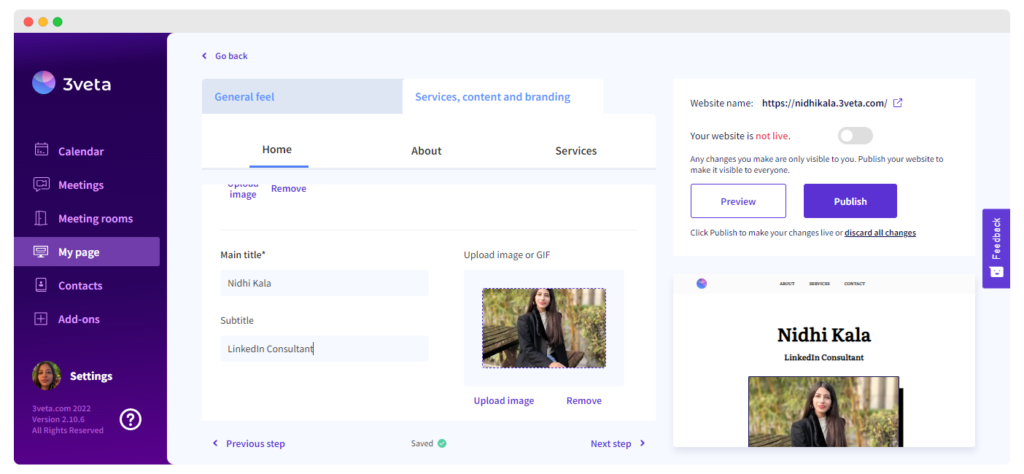
💡Once you have created your website, have a shareable link online and pdf format ready with you to share with prospects
💡Need only a booking page?
If everything you need is a booking page, don’t wait up until the end of this guide. Start creating your booking page right now!
Also Read: How Can a Lawyer Start Providing Online Legal Services?
Craft a compelling offer
Understand this: a high-paying client is an illusion.
Instead, work on crafting a high-paying offer. Doing this will yield you two things: a retainer client and an incredible package your client will pay you for.
A retainer package is a fixed amount the client pays you for a fixed set of deliverables every month. Here’s what you get with a retainer offer:
- Increased scope – a retainer usually spans over more than one project, meaning that you are practically upselling your existing clientele from day one with as many add-on services as they need
- Predictable cashflows – you know exactly how much money you will be paid in the next couple of months. The same applies to your client, who is very much interested in how much they are paying (as opposed to per hour pay)
- Fewer agency problems – with a retainer, the feeling of your client is that you are a part of the team, however, a highly motivated one. In a way, this makes your availability much clearer and contributes to your relationship
How to create such retainer packages: Identify the best-selling consulting services online you offer to your clients. Club them with complementing services together and create a retainer package.
💡Explain your offer to prospects for higher conversions. Walk them through your work process to justify your high-value offer.
If you are an email marketing consultant, your retainer package may look something like this:
Drip email + Email newsletter campaign + Automated email messaging + Prospect nurturing = $4,000 per month
Below is another example of how VECstudio crafts a compelling monthly retainer package. Similarly, they offer three retainer packages for prospects to choose from.
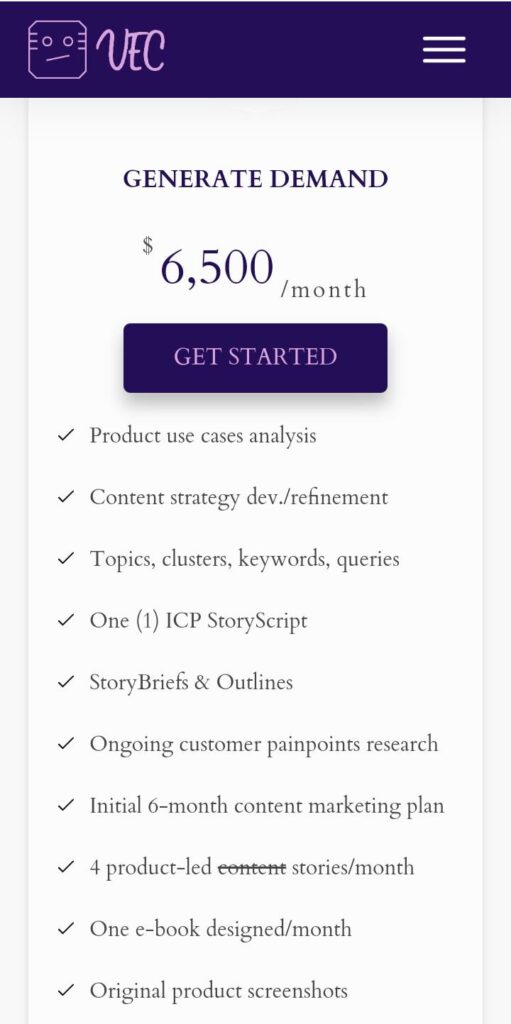
Also Read: Telemedicine Video Conferencing: Everything You Need to Know
Find your stage
Another question that might pop up to you is “How do I sell my consulting services?”
Find the platforms where your target audience is active.
Most people get confused when leveraging social media for their business because they have no idea how lead generation works.
Here’s the simple flow to get the gist:
Follow prospective clients/ send connection requests → create content → engage with their content → nurture them via messages → they become warm prospects → they see your solution-oriented content → connect with you convert → book a call
To understand how lead generation works, let’s first decode the following terms:
Inbound lead generation: When prospects reach out to you directly or via referral sources, your inbound lead generation is stronger. If that happens, either of these might be the case: they have learned about you through social media, content marketing, your website, or referrals from a client, friend, or coworker.
Outbound lead generation: When you reach out to prospects via emails or messages, you are maximizing outbound leads.
Personal branding: When you emphasize your skills, expertise, and your personal side (who you are beyond your profession) either by speaking in webinars and podcasts or by creating content on social channels, you are strengthening your personal brand.
Now, let’s understand how these act as a conversion pillar for your online consulting business.
If your product is expertise, LinkedIn is probably the right stage for you.
- Optimize your LinkedIn profile—clear headshot, compelling headline and cover picture, a detailed about section, case studies in the featured section, and testimonials (if you have!)
- Send a connection request to your ideal prospects with a personal note
- Create content that establishes your credibility—showcase case studies, share client stories and informational content
Here’s a quick 5-step process on how you can generate leads through LinkedIn.
- Optimize your Twitter bio—a snappy headline and cover picture
- Create a Twitter list with your ideal prospects, turn on post notifications for their profile, and drop meaningful comments on their tweets consistently
- Create tweets and Twitter threads focusing on your expertise area
- Participate in Twitter spaces as a speaker and share your expertise in the area you provide consultancy services in
- Connect with people in DMs—send them voice messages, talk about their work and ask for a 1:1 networking call
Few days back, I joined this amazing space on Twitter growth hosted by @NiharikaSodhi @jessievbreugel
— nidhi kala • b2b saas writer (@nidhiikala) January 10, 2022
Here are my 10 learnings from this Twitter space🧵
Facebook groups
- Join Facebook groups where either your target audience or yellow consultants are active.
- Inside the groups, search for keywords like “looking for social media consultant” and pitch to the people who have posted their requirements.
- When someone publishes a post, drop meaningful comments and build a network (and do this consistently)
- From the group, find out people who fall in your ideal target audience category and reach out to them through messages.
Youtube/ Podcasts
- Launch a podcast and talk about the topics you provide services in
- Invite guest speakers (from the industries who you work with!) and do detailed interviews with them
- Have your consultancy service details written in the Youtube or podcast description
- Create a snappy outro talking about the services you offer and how people can reach out to you
- Have the list of guest speakers saved, filter down to your ideal prospects from this list, and reach out to them offering your consultancy services
Cold email/cold DMs (direct messages)
- Make a list of people you want to reach out to. This list should have a company name, website link, contact’s name, email address/ LinkedIn or Twitter profile, and extra notes on how you can help their business with your services.
- For cold emails, search for their email address using tools like Wiza, Hunter.io or Snov.io
- For cold DMs, simply search for their names or profile and send them the message.
- Craft a compelling email/ message by aligning your message for them and how you can contribute as an asset to their business. Few things like appreciation or addressing the problem statement and how your service fills the gap are great emails to convert.
Tools to automate your online consulting business
- 3veta – schedule appointments with your clients and do virtual consultations with your clients via video calls on the platform
- Notion – create shareable templates or questionnaires you’d want to send to your clients
- Streak – track when the emails open and follow up on time for all the cold emails you send to prospects
- Hunter.io – find email addresses of your prospects
- Harlow – track everything from proposals to invoices and client management
- Wave – create a single platform for all your accounting purposes
- DocuSign – sign important documents and contracts
Frequently Asked Questions
How to do online consultations
- Choose a virtual platform to do video calls like 3veta
- Share booking links with clients to help them find the right day and time to do a consultation
- Share the meeting link with them to get on the video call
- Voila, start online consulting
How to sell my online consulting services
To start selling your online consulting services, leverage social media platforms like LinkedIn, Twitter, and Facebook groups. Create content that aligns with your niche, network with people in your industry, and send personalized cold emails to people you want to work with showcasing your expertise and the services you offer.

Nidhi Kala
Nidhi Kala is a freelance writer for B2B SaaS brands in marketing, HR, and eCommerce. When she's not writing, her artistic mind is buried in creating a new journaling spread or exploring calligraphy scripts. Connect with her on LinkedIn.



